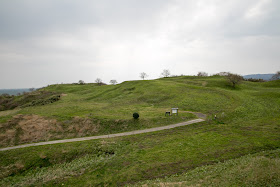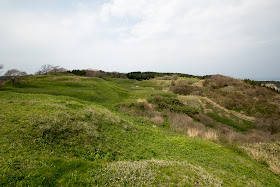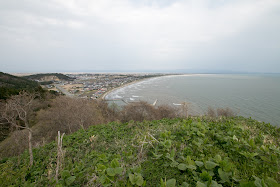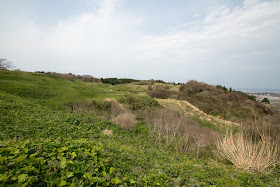Wakimoto Castle
-Majestic base of north star lord-
Overview
Name: Wakimoto castle (Wakimoto-jo)
Alias:
Place: Wakimoto Oga city, Akita
Location: 39.90204927364164, 139.88816627622865
Type: Mountain Castle
Built: 14th century
Remaining remnants: Clay walls and dry moats
Title: 100 more famous Japanese castle
Wakimoto castle (脇本城) is located over a wide hill of 100 meter high at the root of Oga peninsula, one protrudes into Sea of Japan at the middle of Akita prefecture. The site of the castle is ahead of beautifully curved coast continues from Akita plain toward north, and close to former Lake Hachirogata, the second largest lake of Japan disappeared by land reclamation.
Being at the middle of Akita plain and Noshiro plain, large flat areas at the mouth of large river with good port and the mouth of Hachirogata lake, Wakimoto area was the center of coastal marine transportation of Dewa province. Being protected its front side by lake and back side by sea, it is also a suitable place for defense.
Precise year is unknown but Wakimoto castle might be built by 15th century. At the peak of the hill there is a group of square shaped ground of residence and surrounding narrow terraces called as "Umamoriba" area, and this area might be the castle of first period. In the middle of 15th century, Oga peninsula including Wakimoto castle became the territory of Ando clan.
Origin of Ando clan is unknown but it is said as a descendant of indigenous people of Tohoku region. It is said that Ando clan was a leader of sea clan which engaged in fishery and marine transportation around Tohoku region and south part of Hokkaido island. After the fall of Oshu Fujiwara clan which dominated Tohoku region in 1189, Kamakura Shogunate sent their retainer to the region, but appointed Ando clan as the governor of Hokkaido island called as "Ezo island" at that time and let them govern current Mutsu peninsula and Oshima peninsula at both side of Tsugaru straight.
In Muromachi era, Ando clan survived the conflict between two Imperial Household and prospered based on the profit from marine transportation between Hokkaido island and Honshu main island. Their main base Tosaminato port at current Aomori prefecture was one of the largest ports in Japan at that era, continues over 2 kilometer along the sandbank between sea and Lake Jusanko. Furthermore, in 14th century, Ando clan seized Tsuchizaki port at current Akita city, another large port at Sea of Japan, and sent branch family there.
But in 15th century, Nanbu clan which was the lord of Sannohe castle (Aomori prefecture) and governed Pacific Ocean side of current Aomori prefecture rapidly grew and started expansion toward west. In the middle of 15th century, main family of Ando clan left Tosaminato port before the attack of Nanbu clan, and retreated into Hokkaido island. Ando clan continuously tried to recover their territory but failed each time. On the other hand, their branch family called as Minato Ando clan steadily continued and prospered at Tsuchizaki port.
In the middle of 15th century, Minato Ando clan invited main family of Ando clan from Hokkaido island, then Masasue Ando (?-1488), leader of main family, landed into Dewa province (Akita prefecture) and occupied Noshiro area. Masasue reformed Hiyama castle (Akita prefecture) into a large one and used it as a main base, thus this family became to be called as Hiyama Ando clan. Two Ando clans coexisted for nearly 100 years.
But in the middle of 16th century, Hiyama Ando clan lacked its successor and became in crisis of extinction. Facing this situation, Chikasue Ando (1539-1587), who was the leader of Hiyama Ando clan but also born from the mother of Minato Ando clan, united two families in 1570. Chikasue beat Asari clan at Hinai area and expanded his territory, and further tried to invade into Nanbu territory but this was rejected. In 1577, Chikasue significantly expanded Wakimoto castle and used as his main base, to control both of Akita area, Noshiro area and regional marine transportation.
Chikasue used another peak faces the sea as new castle area, and now this part is called as "Uchidate" area. Two ridges separated from the peak toward east and south, and residence of Chikasue was built at the tip of eastward ridge. This residence was a large square shaped flat space of 100 meter long, and protected over 5 meter tall clay wall. At the middle of this residence and peak there are several terraces having the ruin of the well.
At southward ridge large terraces of two layers are built toward Cape Oibana, which might be used as a residence of retainers. It is said that the tip of this area collapsed and disappeared into the sea became of severe earthquake, and surely the castle area was unnaturally finished. There might be a watching place and central area existed ahead of remaining ruins. Between two peak, an old large road called as Tenkamichi passes from hillside toward the tip of Oga peninsula.
Outside these main areas, many defense facilities such as clay wall or dry moat wee built at surrounding hills. Between new castle area and old castle area, a road protected by clay wall is built over 300 meter. Total castle area spreads over 1,500 meter long and 1,000 meter wide, and is one of the largest medieval castle in eastern Japan. At the eastern hillside, castle town spreads along the coast over 1 kilometer, which might be protected by outer barrier. Compared with Hiyama castle which was the former main base of Ando clan, structure of Wakimoto castle is larger and gentle, then Wakimoto castle is a place of reign rather than one of defense.
Chikasue processed centralization of Akita clan and also communicated with central rulers such as Nobunaga Oda (1534-1582) and Hideyoshi Toyotomi (1537-1598). Chikasue overcame rebellion of dissatisfied retainer of former Minato Ando clan, and finally became the warlord which held two third of Dewa province. Chikasue changed his surname from Ando to Akita, and still fought against other local lords remaining Dewa province such as Onodera clan or Tozawa clan, but died in ill in 1587. His talent and braveness was praised as "it is like the Big Dipper shining in the north sky".
After the death of Chikasue, as a reaction of rapid expansion, former person of Minato Ando clan rebelled to Sanesue Akita (1576-1660), son of Chikasue, cooperating with surrounding lords. Sanesue fell into severe situation and besieged at Hiyama castle, but barely rejected attack of rebel army and could continue as a feudal lord under Toyotomi government. Sanesue used Minato castle at Tsuchizaki port then Wakimoto castle was abolished at that time. After twist and turns, Akita clan continued as a feudal lord under Edo Shogunate as a lord of Miharu castle (Fukushima prefecture).
Now all building was lost but structures of terraces well remains over the hill. Now all the tree of core area is cut and long line of flat terraces looks like a golf course from a distance, but sheer slopes, clay walls and dry moats clearly shows here is surely a part of castle. Scenery from the castle consist of Wakimoto town, curved white sand coast and blue ocean is brilliant, and it is becoming as a main base of north star lord along with majestic structure. This castle is not so famous as it is used only for short period and locates at distant place, but it is an interesting place to visit if passing nearby.
25 minutes walk from JR East Oga Namahage line (Oga line) Wakimoto station. 20 minutes drive from Akita Jidoshado Expressway Showa-Ogahanto interchange.
Hiyama Castle -Large size mountain fortress of Great Sunrize lord-
Miharu Castle -Castle of hermit in flower town of long history-
Sannohe Castle -Sailing ship shaped castle survived heavy storm-
Type: Mountain Castle
Built: 14th century
Remaining remnants: Clay walls and dry moats
Title: 100 more famous Japanese castle
Brief History
Wakimoto castle (脇本城) is located over a wide hill of 100 meter high at the root of Oga peninsula, one protrudes into Sea of Japan at the middle of Akita prefecture. The site of the castle is ahead of beautifully curved coast continues from Akita plain toward north, and close to former Lake Hachirogata, the second largest lake of Japan disappeared by land reclamation.
Being at the middle of Akita plain and Noshiro plain, large flat areas at the mouth of large river with good port and the mouth of Hachirogata lake, Wakimoto area was the center of coastal marine transportation of Dewa province. Being protected its front side by lake and back side by sea, it is also a suitable place for defense.
Origin of Wakimoto castle and Ando clan
Precise year is unknown but Wakimoto castle might be built by 15th century. At the peak of the hill there is a group of square shaped ground of residence and surrounding narrow terraces called as "Umamoriba" area, and this area might be the castle of first period. In the middle of 15th century, Oga peninsula including Wakimoto castle became the territory of Ando clan.
Origin of Ando clan is unknown but it is said as a descendant of indigenous people of Tohoku region. It is said that Ando clan was a leader of sea clan which engaged in fishery and marine transportation around Tohoku region and south part of Hokkaido island. After the fall of Oshu Fujiwara clan which dominated Tohoku region in 1189, Kamakura Shogunate sent their retainer to the region, but appointed Ando clan as the governor of Hokkaido island called as "Ezo island" at that time and let them govern current Mutsu peninsula and Oshima peninsula at both side of Tsugaru straight.
In Muromachi era, Ando clan survived the conflict between two Imperial Household and prospered based on the profit from marine transportation between Hokkaido island and Honshu main island. Their main base Tosaminato port at current Aomori prefecture was one of the largest ports in Japan at that era, continues over 2 kilometer along the sandbank between sea and Lake Jusanko. Furthermore, in 14th century, Ando clan seized Tsuchizaki port at current Akita city, another large port at Sea of Japan, and sent branch family there.
Reunion of Ando clan and move to Wakimoto castle
But in 15th century, Nanbu clan which was the lord of Sannohe castle (Aomori prefecture) and governed Pacific Ocean side of current Aomori prefecture rapidly grew and started expansion toward west. In the middle of 15th century, main family of Ando clan left Tosaminato port before the attack of Nanbu clan, and retreated into Hokkaido island. Ando clan continuously tried to recover their territory but failed each time. On the other hand, their branch family called as Minato Ando clan steadily continued and prospered at Tsuchizaki port.
In the middle of 15th century, Minato Ando clan invited main family of Ando clan from Hokkaido island, then Masasue Ando (?-1488), leader of main family, landed into Dewa province (Akita prefecture) and occupied Noshiro area. Masasue reformed Hiyama castle (Akita prefecture) into a large one and used it as a main base, thus this family became to be called as Hiyama Ando clan. Two Ando clans coexisted for nearly 100 years.
But in the middle of 16th century, Hiyama Ando clan lacked its successor and became in crisis of extinction. Facing this situation, Chikasue Ando (1539-1587), who was the leader of Hiyama Ando clan but also born from the mother of Minato Ando clan, united two families in 1570. Chikasue beat Asari clan at Hinai area and expanded his territory, and further tried to invade into Nanbu territory but this was rejected. In 1577, Chikasue significantly expanded Wakimoto castle and used as his main base, to control both of Akita area, Noshiro area and regional marine transportation.
Structure of Wakimoto castle
Chikasue used another peak faces the sea as new castle area, and now this part is called as "Uchidate" area. Two ridges separated from the peak toward east and south, and residence of Chikasue was built at the tip of eastward ridge. This residence was a large square shaped flat space of 100 meter long, and protected over 5 meter tall clay wall. At the middle of this residence and peak there are several terraces having the ruin of the well.
At southward ridge large terraces of two layers are built toward Cape Oibana, which might be used as a residence of retainers. It is said that the tip of this area collapsed and disappeared into the sea became of severe earthquake, and surely the castle area was unnaturally finished. There might be a watching place and central area existed ahead of remaining ruins. Between two peak, an old large road called as Tenkamichi passes from hillside toward the tip of Oga peninsula.
Outside these main areas, many defense facilities such as clay wall or dry moat wee built at surrounding hills. Between new castle area and old castle area, a road protected by clay wall is built over 300 meter. Total castle area spreads over 1,500 meter long and 1,000 meter wide, and is one of the largest medieval castle in eastern Japan. At the eastern hillside, castle town spreads along the coast over 1 kilometer, which might be protected by outer barrier. Compared with Hiyama castle which was the former main base of Ando clan, structure of Wakimoto castle is larger and gentle, then Wakimoto castle is a place of reign rather than one of defense.
Death of north star lord and afterward
Chikasue processed centralization of Akita clan and also communicated with central rulers such as Nobunaga Oda (1534-1582) and Hideyoshi Toyotomi (1537-1598). Chikasue overcame rebellion of dissatisfied retainer of former Minato Ando clan, and finally became the warlord which held two third of Dewa province. Chikasue changed his surname from Ando to Akita, and still fought against other local lords remaining Dewa province such as Onodera clan or Tozawa clan, but died in ill in 1587. His talent and braveness was praised as "it is like the Big Dipper shining in the north sky".
After the death of Chikasue, as a reaction of rapid expansion, former person of Minato Ando clan rebelled to Sanesue Akita (1576-1660), son of Chikasue, cooperating with surrounding lords. Sanesue fell into severe situation and besieged at Hiyama castle, but barely rejected attack of rebel army and could continue as a feudal lord under Toyotomi government. Sanesue used Minato castle at Tsuchizaki port then Wakimoto castle was abolished at that time. After twist and turns, Akita clan continued as a feudal lord under Edo Shogunate as a lord of Miharu castle (Fukushima prefecture).
Now all building was lost but structures of terraces well remains over the hill. Now all the tree of core area is cut and long line of flat terraces looks like a golf course from a distance, but sheer slopes, clay walls and dry moats clearly shows here is surely a part of castle. Scenery from the castle consist of Wakimoto town, curved white sand coast and blue ocean is brilliant, and it is becoming as a main base of north star lord along with majestic structure. This castle is not so famous as it is used only for short period and locates at distant place, but it is an interesting place to visit if passing nearby.
Access
25 minutes walk from JR East Oga Namahage line (Oga line) Wakimoto station. 20 minutes drive from Akita Jidoshado Expressway Showa-Ogahanto interchange.
Related Castles
Hiyama Castle -Large size mountain fortress of Great Sunrize lord-
Miharu Castle -Castle of hermit in flower town of long history-
Sannohe Castle -Sailing ship shaped castle survived heavy storm-

























































































































































































































































































No comments:
Post a Comment